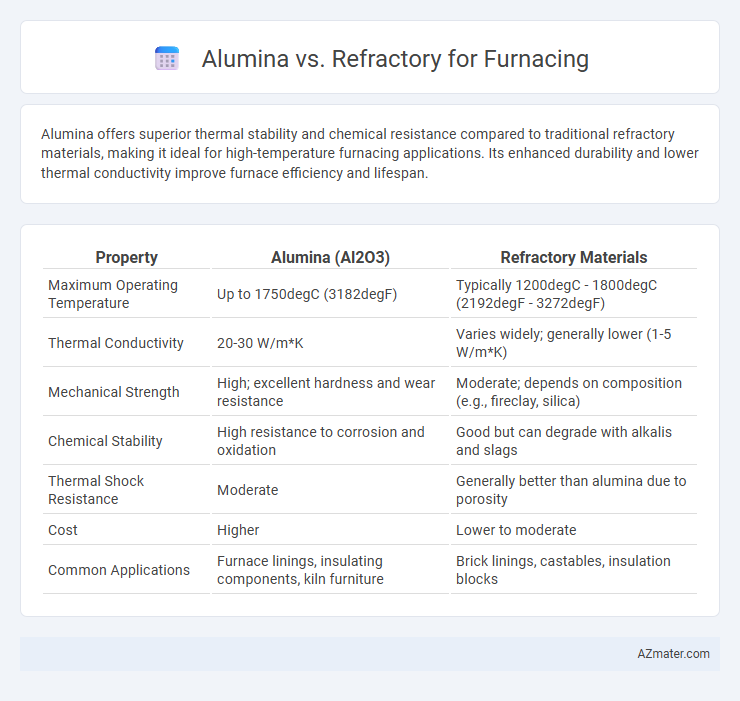Alumina offers superior thermal stability and chemical resistance compared to traditional refractory materials, making it ideal for high-temperature furnacing applications. Its enhanced durability and lower thermal conductivity improve furnace efficiency and lifespan.
Table of Comparison
| Property | Alumina (Al2O3) | Refractory Materials |
|---|---|---|
| Maximum Operating Temperature | Up to 1750degC (3182degF) | Typically 1200degC - 1800degC (2192degF - 3272degF) |
| Thermal Conductivity | 20-30 W/m*K | Varies widely; generally lower (1-5 W/m*K) |
| Mechanical Strength | High; excellent hardness and wear resistance | Moderate; depends on composition (e.g., fireclay, silica) |
| Chemical Stability | High resistance to corrosion and oxidation | Good but can degrade with alkalis and slags |
| Thermal Shock Resistance | Moderate | Generally better than alumina due to porosity |
| Cost | Higher | Lower to moderate |
| Common Applications | Furnace linings, insulating components, kiln furniture | Brick linings, castables, insulation blocks |
Introduction to Alumina and Refractory Materials
Alumina and refractory materials are essential components in furnacing processes, with alumina primarily composed of aluminum oxide (Al2O3) known for its high melting point and excellent thermal stability. Refractory materials include a broader category of heat-resistant substances, such as fireclay, silica, and magnesite, designed to withstand extreme temperatures and harsh chemical environments. Understanding the distinct thermal and chemical properties of alumina versus other refractory materials is critical for optimizing furnace lining performance and longevity.
Understanding the Role of Furnacing
Alumina and refractory materials both play crucial roles in furnacing by providing thermal resistance and protecting furnace structures from extreme temperatures. Alumina offers high melting points and excellent chemical stability, making it ideal for linings exposed to aggressive environments. Refractories, composed of various oxides, contribute enhanced durability and insulation, ensuring efficient heat retention and extended furnace lifespan during high-temperature processes.
Composition and Properties of Alumina
Alumina, primarily composed of aluminum oxide (Al2O3), exhibits high melting points around 2072degC and exceptional chemical stability, making it ideal for refractory applications in furnacing. Its excellent thermal conductivity, mechanical strength, and resistance to slag corrosion significantly enhance furnace lining durability compared to traditional refractories like fireclay or silica. The superior purity and density of alumina refractories enable higher temperature operations and prolonged service life in industrial furnaces.
Key Characteristics of Refractory Materials
Refractory materials for furnacing primarily differ in composition and thermal properties, with alumina-based refractories offering high melting points above 2050degC and excellent resistance to chemical corrosion and thermal shock. Key characteristics include high refractoriness, strong mechanical strength at elevated temperatures, and minimal thermal expansion to prevent cracking during rapid temperature changes. Alumina refractories demonstrate superior abrasion resistance and stability in oxidizing environments, making them ideal for high-temperature industrial furnaces that require durability and long service life.
Performance Comparison: Alumina vs Refractory
Alumina offers superior thermal stability and chemical resistance compared to traditional refractory materials, making it ideal for high-temperature furnacing applications. Its higher melting point and enhanced abrasion resistance result in longer service life and reduced maintenance costs in industrial environments. Refractory materials, while effective in general heat containment, tend to degrade faster under extreme thermal cycling and corrosive atmospheres, limiting their overall performance relative to alumina.
Thermal Resistance and Heat Management
Alumina refractories exhibit superior thermal resistance due to their high melting point of approximately 2072degC, making them ideal for furnacing applications requiring prolonged exposure to extreme heat. Their excellent thermal stability and low thermal conductivity enable efficient heat management, reducing heat loss and energy consumption during high-temperature operations. Compared to other refractory materials, alumina maintains structural integrity under cyclic thermal loads, ensuring durability and enhanced performance in industrial furnaces.
Durability and Lifespan in High-Temperature Environments
Alumina refractories exhibit superior durability and extended lifespan in high-temperature environments due to their high melting point of approximately 2072degC and excellent resistance to chemical corrosion and thermal shock. Compared to other refractory materials, alumina's dense microstructure enhances mechanical strength and minimizes wear under cyclic thermal conditions, making it ideal for furnacing applications in steelmaking and glass manufacturing. The longevity of alumina refractories reduces maintenance frequency and operational downtime, optimizing overall furnace performance and cost-efficiency.
Cost-Effectiveness and Economic Factors
Alumina materials offer superior thermal resistance and durability, leading to longer service life in furnacing applications, which reduces replacement frequency and overall operational costs. Refractory options, often comprising cheaper raw materials, may have lower upfront expenses but generally require more frequent maintenance and replacement, affecting long-term economic efficiency. Evaluating the total cost of ownership, including energy savings and downtime reduction associated with alumina's enhanced performance, is critical for cost-effective furnacing solutions.
Typical Applications in Modern Furnaces
Alumina is extensively used in modern furnaces for applications requiring high thermal conductivity and resistance to acidic slags, such as in glass melting and kiln linings. Refractory materials, particularly high-chrome and magnesia-based refractories, are preferred for environments with extreme mechanical stress and exposure to alkaline slags, common in steelmaking and cement production furnaces. Selection between alumina and refractory materials depends on the specific thermal, chemical, and mechanical demands of the furnace application.
Conclusion: Choosing the Right Material for Furnacing
Selecting the right material for furnacing depends heavily on the temperature, chemical environment, and mechanical stresses involved, with alumina offering superior thermal stability and corrosion resistance at high temperatures. Refractory materials provide versatility and cost-effectiveness for applications with lower temperature requirements or where thermal shock resistance is critical. Prioritizing alumina enhances durability and efficiency in extreme conditions, while refractories remain optimal for general-purpose furnacing needs.

Infographic: Alumina vs Refractory for Furnacing
 azmater.com
azmater.com